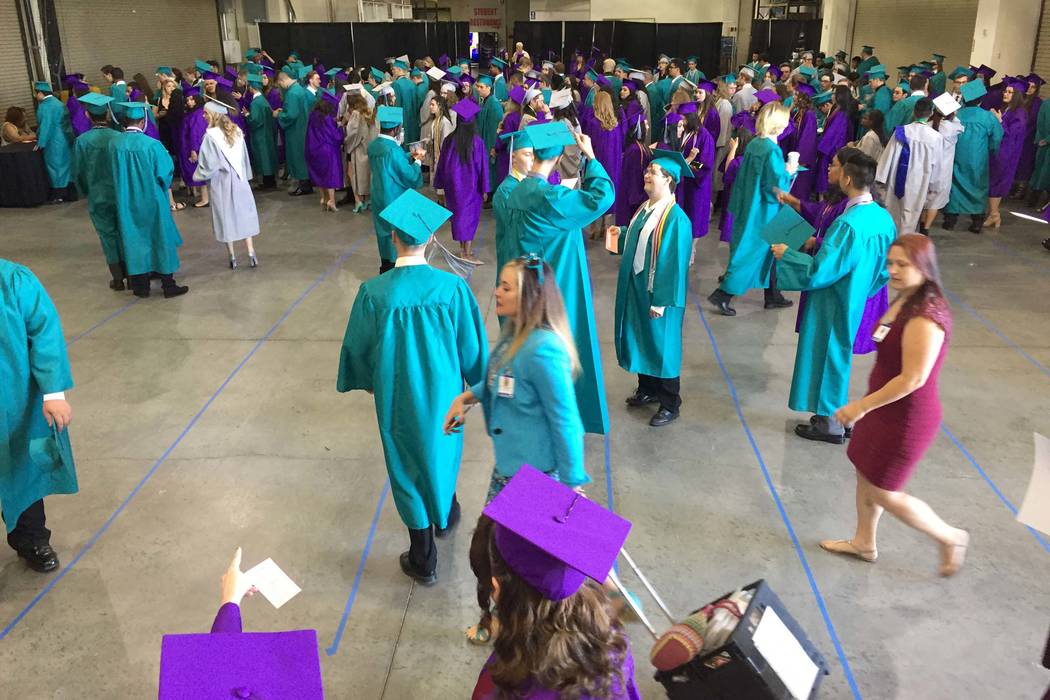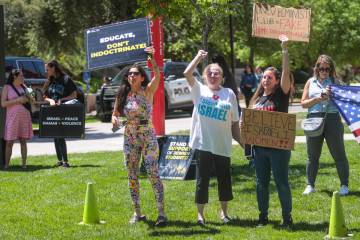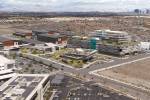Nevada, Clark County high school graduation rates increase
High school graduation rates in Nevada and Clark County inched slightly higher in 2019, with both recording new highs, according to state data released Thursday.
The statewide graduation rate for the class of 2019 was 84.11 percent, breaking the previous year’s record. Though the 2019 increase was less than one percentage point over last year, graduation rates have risen 3.26 percentage points since 2017.
Clark County School District high schools bettered the state average slightly, posting an 85.8 percent graduation rate for 2019, up half of one percentage point over last year. Washoe County School District graduates posted a 86.05 percent graduation rate, up 1.66 percentage points over 2018.
Jhone Ebert, superintendent of public instruction for the state, praised the improvement shown by schools.
“The rising graduation rate coincides with other positive trends reported this year, including 184 schools that increased their rating by one or more stars and assessment outcomes that indicate that more of our students are demonstrating proficiency and college and career readiness,” Ebert said in a statement.
Jonathan Moore, deputy superintendent of student achievement, said the improvement over two years shows the value of investment into educational programs like Victory Schools, a dedicated fund for underperforming schools in poor ZIP codes established by the Legislature in 2015.
The state’s 13,000 Career and Technical Education students also continued to shine, with the highest average graduation rate at 94.1 percent, Moore said.
Achievement gaps persist
Moore said it’s important to be mindful of the achievement gap that persists.
While all other student ethnic groups had higher graduation rates in 2019, the state’s Native American students showed a decrease from 2018. The group’s graduation rates have increased since 2017 by less than half of a percentage point.
English-language learners, meanwhile, have shown a 4.86 percent decrease in graduation rates over two years.
The state only recently began tracking graduation rates for homeless and foster youth. From 2018-19, graduation rates increased among students experiencing homelessness by 2 percent, but decreased among foster youth by 2 percent.
The State Public Charter School Authority showed one of the more dramatic gains among all districts, with a seven-point gain in graduation rates over last year and a 12.51 percent gain since 2017. There’s not just one factor driving the gains across the board, SPCSA Executive Director Rebecca Feiden said.
“Our schools are community-based, so it’s likely something different at each one,” Feiden said. “Our cohorts range from 15 to 110 students, so we vary quite a bit.”
Some rural districts showed the greatest declines, which Moore said can sometimes be explained by the effects of just a few transfers in a relatively small school population.
A handful of CCSD high schools showed the most dramatic gains, including Indian Springs High School, which raised its graduation rate from 95 percent in 2018 to 100 percent in 2019. Desert Pines raised its rate from 84 percent to 90 percent. Virgin Valley increased its graduation rate from 87 percent to 92 percent.
Interventions will be considered
Mike Barton, CCSD’s chief college, career, equity and school choice officer, said the district is especially proud of those schools. For schools that trended downward, the district will analyze the data and work with principals to determine if interventions like more academic counseling are needed, he said.
Laughlin Junior and Senior High School dropped from a 93.8 percent graduation rate in 2018 to 79.2 percent in 2019. Mojave High School in North Las Vegas posted a slight decrease as well, from 88.6 percent in 2018 to 86.4 percent in 2019.
Given that the district’s graduation rate in 2011 hovered around 59 percent, the improvement since has been huge, Barton said.
“Based on the overall size of the district, a half-percent increase is pretty good,” said Barton.
He added that the district hopes to see a 90 percent graduation rate by 2024, but that the district also considered other measures of student success, like remediation rates once students leave high school and enroll at Nevada System of Higher Education campuses.
“It’s an important metric, don’t get me wrong, but it’s one of many,” Barton said. “We’re not solely focused on the graduation rate.”
Contact Aleksandra Appleton at 702-383-0218 or aappleton@reviewjournal.com. Follow @aleksappleton on Twitter.





























